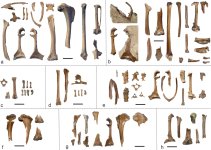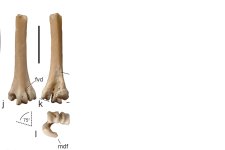Systematic palaeontology
Aves Linnaeus, 1758
Trogoniformes American Ornithologists’ Union, 1886
Trogonidae Lesson, 1828
Eotrogon gen. nov.
Type species: Eotrogon stenorhynchus sp. nov.
Diagnosis: Differs from Masillatrogon, Primotrogon, and all crown group Trogoniformes in a mediolaterally narrower rostral portion of the upper beak. Furthermore differs from Masillatrogon in a longer acromion of the scapula and a proportionally somewhat longer carpometacarpus (ratio ulna length: carpometacarpus length 1.9 versus 2.0‒2.1 in M. pumilio). Distinguished from Primotrogon in that the coracoid has a longer processus procoracoideus and a hook-shaped processus acrocoracoideus. Differs from Foshanornis in that rostrum of upper beak is proportionally shorter and dorsoventrally deeper, humerus with longer crista deltopectoralis. Comparisons with Septentrogon are not possible owing to a lack of overlap in the fossil material (see comments below).
Etymology: The taxon name is derived from έως (eos; Gr.): dawn.
Taxonomic remarks: The only unambiguously identified fossil of Septentrogon madseni from the Danish Fur Formation is the holotype neurocranium, which belongs to a larger species than the fossil from the London Clay (see species diagnosis). The S. madseni holotype cannot be directly compared with the fossils from the London Clay, so we are unable to exclude the possibility that the fossils from the London Clay belong to the taxon Septentrogon. However, there is currently no basis for a referral to the latter taxon other than the similar age and geographical proximity of the respective fossil localities. A referral to Septentrogon would also be poorly substantiated, because there are undescribed fossils of other trogoniformlike birds in the Daniels collection (which appear to be more distantly related to the new taxon and crown group Trogoniformes), and it is currently not possible to unambiguously
differentiate any of these from Septentrogon.
Eotrogon stenorhynchus, sp. nov.
Holotype: NMS.Z.2021.40.83 (Fig. 1a; partial skeleton including tip of upper beak, left quadrate, both pterygoids, a cervical vertebra, right scapula, both coracoids, fragments of the furcula, cranial-most portion of sternum, partial left and right humeri, left ulna, left carpometacarpus), collected in 1994 by M. Daniels (original collector’s number WN 94814).
Diagnosis: As for genus. The new species is smaller than Septentrogon madseni; the limb bones correspond to those of Primotrogon wintersteini in their length and the neurocranium of P. wintersteini measures about 21 mm and is therefore distinctly shorter than that of S. madseni, which has a neurocranium length of 25 mm (Kristoffersen 2002a); a heterodactyl tarsometatarsus from the Fur Formation, which may belong to S. madseni, has a length of 15.0 mm (versus 11.3 mm in the new species). The new species is larger than Masillatrogon pumilio.
Etymolog: The species epithet is derived from stenos (στενός; Gr.): narrow, and the Latinised form of rynchos (ῥύγχος; Gr.): beak.
Type locality and horizon: Walton-on-the-Naze, Essex, United Kingdom; Walton Member of the London Clay Formation (previously Division A2; Jolley 1996; Rayner et al. 2009; Aldiss 2012); early Eocene (early Ypresian, 54.6‒55 Ma; Collinson et al. 2016).
Referred specimens: NMS.Z.2021.40.84 (Fig. 1b; partial left coracoid, partial right coracoid and partial furcula in matrix, partial right scapula, caudal portion of left scapula, distal portion of left humerus, left ulna, proximal end of right ulna, proximal ends of both radii, distal portion of right radius, right carpometacarpus, distal portion of left carpometacarpus, both phalanges proximales digiti majoris and other wing phalanges, left os carpi radiale), collected in 2000 by M. Daniels (original collector’s number WN 00010A). NMS.Z.2021.40.85 (Fig. 1c; axis and fragments of other vertebrae, distal end of right tibiotarsus, right tarsometatarsus, several pedal phalanges), collected in 1989 by M. Daniels (original collector’s number WN 89608). NMS.Z.2021.40.86 (Fig. 1d; fragment of pelvis, right tibiotarsus lacking proximal end, left tibiotarsus lacking distal portion, several pedal phalanges), collected in 1994 by M. Daniels (original collector’s number WN 94827). NMS.Z.2021.40.87 (Fig. 1e; partial mandible, basiurohyal bone, a few vertebrae and fragments of the synsacrum, left coracoid, fragmentary right coracoid, partial
furcula, proximal portion of a radius, partial right carpometacarpus, proximal and distal portions of left carpometacarpus, left phalanx proximalis digiti majoris), collected in 1989 by M. Daniels (original collector’s number WN 89606). NMS.Z.2021.40.88 (Fig. 1f; proximal and distal portions of
both humeri) collected in 1993 by M. Daniels (original collector’s number WN 93793). NMS.Z.2021.40.89 (Fig. 1g; partial skeleton including fragments of sternum, right coracoid, sternal extremity of left coracoid, proximal portions of both humeri) collected in 2000 by M. Daniels (original collector’s
number WN 00006). NMS.Z.2021.40.90 (Fig. 1h; left coracoid, cranial extremity of left scapula, distal end of left humerus, distal end of left ulna, proximal portion of ?left radius) collected in 1993 by M. Daniels (original collector’s number WN 93773).
Measurements (maximum length, in mm): NMS.Z.2021.40.83: left coracoid, 17.0; right coracoid, 16.9;
left humerus, length as preserved, 23.4; estimated total length (by comparison with partial right humerus), ~ 25.2; left ulna, 29.5; left carpometacarpus, 15.7. NMS.Z.2021.40.85: right tarsometatarsus, 11.5. NMS.Z.2021.40.87: left coracoid, 15.1; right carpometacarpus, 13.5. NMS.Z.2021.40.84: left ulna, 30.0; right carpometacarpus, 15.5. NMS.Z.2021.40.86: right tibiotarsus, length as preserved, 18.4; estimated total length (by comparison with proximal portion of left tibiotarsus), ~ 24.6. NMS.Z.2021.40.89: right coracoid, 15.1.
Remarks: The specimens show some differences in size, with NMS.Z.2021.40.87, NMS.Z.2021.40.88,
NMS.Z.2021.40.89, and NMS.Z.2021.40.90 being smaller than the holotype. This size difference may indicate the involvement of two species but could also be due to sexual dimorphism in size (the sexes of extant trogons mainly exhibit sexual dimorphism in plumage colouration, even though Solórzano and Oyama 2010 reported different bill lengths for Pharomachrus mocinno). Pending the discovery of further material, we prefer an assignment of all fossils to a single species.
Trogoniformes American Ornithologists’ Union, 1886
Trogonidae Lesson, 1828
cf. Paratrogon Lambrecht, 1933
cf. Paratrogon gallicus (Milne-Edwards, 1871)
Referred specimen: NMB Sau.2072 (Fig. 7j‒l; left tarsometatarsus lacking proximal end).
Locality and horizon: Saulcet, Allier, France; early Miocene, Aquitanian (MN1 ‒ base of MN2; ca. 22.5 Ma [De Pietri et al. 2011]).
Measurements (in mm): Length as preserved, 12.3.
Taxonomic remarks: Paratrogon gallicus was so far known from two isolated humeri; a photograph of the only currently traceable specimen is shown here for the first time (Fig. 5g, h). We identify a partial tarsometatarsus of a similar-sized trogoniform species from the geographical area where the previous Paratrogon fossils were found. Even though direct comparisons of the material are not possible owing to a lack of overlap in the bones, it is the most parsimonious assumption that the new partial tarsometatarsus belongs to P. gallicus or a closely related species.
Fred
Fig. 1. Overview of main bones preserved in the specimens of Eotrogon stenorhynchus, gen. et sp. nov. from the London Clay of Walton-on-the-Naze. a NMS.Z.2021.40.83 (holotype). b NMS.Z.2021.40.84. c NMS.Z.2021.40.85. d NMS.Z.2021.40.86. e NMS.Z.2021.40.87. f NMS.Z.2021.40.88. g NMS.Z.2021.40.89. h NMS.Z.2021.40.90. The scale bars equal 5 mm. [Colour online]
Fig. 2. j‒l Distal portion of the left tarsometatarsus of cf. Paratrogon gallicus from the early Miocene of Saulcet (Saint-Gérand-le-Puy area) in France (NMB Sau.2072) in j dorsal,






